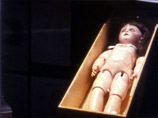|
December
15, Thursday, 7:30PM,
2005
Filmic
Essays: Daniel Eisenberg
Born
in Israel in 1954, Daniel Eisenberg
studied film at the State University of New
York at Binghamton with Ernie Gehr, Larry Gottheim,
Klaus Wyborny, Saul Levine and Ken Jacobs. For
three decades, Daniel has been making nonfiction
independent and avant-garde work, "interrogating
"official" histories and investigating
personal stories within the context of major
social and political events." He lived
and worked in Boston for 14 years but now resides
in Chicago where he is the Chair of the Department
of Film, Video, and New Media at the School
of the Art Institute of Chicago.
Exhibition/Screenings: Museum
of Modern Art, NY; University of Amsterdam;
Goldsmiths College, University of London; Musee
National d'Art Moderne, Centre Georges Pompidou,
Paris; Whitney Museum of American Art, NY; Bangkok
Experimental Film Festival; Pacific Film Archive,
Berkeley; Musee du Cinema, Brussels; Filmmuseum,
Munich. Collections: Centre Georges Pompidou;
Museum of Modern Art; Freunde der Deutschen
Kinemathek; Nederlands Film Museum. Awards:
Illinois Arts Council Artists Fellowship; John
Simon Guggenheim Memorial Foundation Fellowship;
DAAD Berlin Fellowship. http://www.danieleisenberg.com
Displaced
Person (11min, 16mm, 1981)
DISPLACED PERSON works with a carefully chosen
set of particular elements in order to explore
the larger questions within the historical
field. Stately and sinuous passages from a
Beethoven string quartet create a complex
argumentation around images and text. This
music, both sympathetic and distanced, establishes
rhythm and breadth in relation to a radio
interview with Claude Levi-Strauss, and archival
footage obtained from rephotographing Marcel
Ophul's The Sorrow and the Pity. These elements
wheel through many revolutions of repetitions
and combinations, forming multiple perspectives.
Through recontextualization, meaning blossoms
rationally and incongruously like the alleged
blossoming of flowers that took place in the
dead of winter in wartime Germany, brought
on by the intense temperatures of exploding
shells.DISPLACED PERSON is a tether that entwines
and unravels; by necessity and the nature
of its subject it is inconclusive. - Canyon
Cinema
DE:"I
work slowly and quietly. It's important
for me. There's a time to talk about your
work and a time not to, and I feel that
the balance for me personally is that there's
a huge amount of timenot to be public with
the work, and the public part of it, whether
it's in discussion or showing is a smaller
part of that process. You know in the seventies
there were many experimental filmmakers
who did a lot of substantial work, and much
of their work is really wonderful and important,
but I also rejected it for myself, in the
sense that I never felt comfortable taking
on the mantle of the "structural"
approach. It always seemed that I could
come up with any number of structural or
formal experiments in film and yet they
would have nothing of me in them, and that
was very disturbing. So I had to figure
out a way out of that. One of those ways
was with camera movement, and not in the
sense that it had anything to do with Brakhage's
idea of camera movement, which, as I read
it, is in some ways an extension of his
eye and his life. I was thinking about it
much the way Pollock was trying to move
away from easel painting. I was trying to
use the camera to register formally, emotionally,
and physically an image with velocity, with
gravity, and with meaning, all at once.
Not an easy task and I'm not so sure it
works in every case but it was at least
a way out.
As
far as the work with found footage, I was
interested in simultaneity, with the possibilities
of what could happen at the same time in
sound and image, and also because I work
very often in the documentary film world
I was trying to challenge some of the conventions
there as well. So a film like "Displaced
Person" somehow finds itself in the
middle of those concerns as well. I saw
what the problems were with the documentaryfilm,
how it was always forcibly hammered into
shape, and how judgments were being made
before anyone really had the right to make
them. I wanted to make a work that had a
structure that was open enough for multiple
readings, for readings that were contrary
to each other, for dead ends, for finding
oneself in a situation where there were
too many choices sometimes. So it was a
wonderful thing to create a film that invited
the viewer to be as active as the maker.
And I think these solutions arose out of
thinking very precisely about issues that
interested me, and which were really outside
of the mainstream of the film discussions
that were taking place at the time."
- from an interview with Alf Bold, september
1991
http://mfj-online.org/journalPages/MFJ27/ABoldDEisenb.html
Cooperation
of Parts (42min, 16mm, 1987)
 |
|
The
images for COOPERATION OF PARTS were shot
in Europe in 1983. The film begins at a train
station in Calais, France and ends on a street
in Radom, Poland. In between are images of
Paris, Munich, Dachau, Berlin, Warsaw and
Auschwitz/Birkenau. Unlike most films that
deal with the Holocaust, COOPERATION OF PARTS
takes place firmly in the present and does
not attempt to recapitulate history. Using
lists, descriptions of photographs, a catalog
of proverbs, images of streets, trains, ruins
and riots, the film explores the territory
of the recent past with a second generation
perspective, distanced through time and reflection.
With the visual field as a touchstone for
a complex set of narrative associations, the
film spins a tight web of memory, history,
and experience. It is within this web that
the film finds its wider significance: as
a model for how daily life, history, first
hand and second hand experience bind, through
purpose or chance, to form identity itself.
- Canyon Cinema
|
